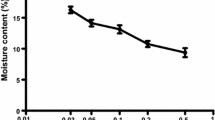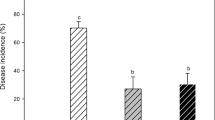Abstract
The effect of soil moisture on activity and dynamics of the soilborne pathogen Rhizoctonia solani and of its antagonist Trichoderma harzianum were studied in soil under greenhouse conditions. Pots filled with a mixture of soil and sand were inoculated at the same time with R. Solani AG-4, produced on rice grains, and with T. Harzianum, produced on wheat bran. Soil moisture was periodically monitored and kept at four levels varying from − 0.0007 to − 1.03 MPa. To test the fungal activity, bean seeds were sown immediately after soil infestation and 20, 60, 180 and 360 days after soil infestation (DAI), and 3, 6, 12 and 18 DAI in a complementary experiment. The pathogen effectively survived in the soil in absence of host tissue at least one year, although the severity of root rot and the damage to plants were lower in the test at 360 DAI than in the previous ones. Soil moisture did not affect the severity of root rot. The pathogen could more easily be recovered from drier soils, but in the presence of T. Harzianum population density of R. Solani was reduced, except in the driest soil. T. Harzianum could sometimes compensate for negative effects of R. Solani on emergence and plant weight, which was especially observed in the first activity test and in the test carried out 180 DAI. However, when the pathogen was well established in the soil, antagonistic protection was lower. Antagonistic effects were hardly detectable at 360 DAI. The antagonistic ability and activities of T. Harzianum were greater in soils held at intermediate soil moisture levels than in wet or dry soils.
Zusammenfassung
Der Einfluss der Bodenfeuchte auf die Aktivität und Dynamik des bodenbürtigen Pathogens Rhizoctonia solani und seines Antagonisten Trichoderma harzianum wurde unter Gewächshausbedingungen im Boden untersucht. Das Inokulum von R. Solani AG-4 wurde auf Reiskörnern, das von T. Harzianum auf Weizenkleie produziert. Beide Pilze wurden gleichzeitig in ein Erde/Sand-Gemisch in Töpfen inokuliert. Die Bodenfeuchte wurde regelmäßig kontrolliert und auf vier Stufen zwischen −0,0007 und −1,03 MPa eingestellt. Um die pilzliche Aktivität zu testen, wurden Bohnensamen in die infizierte Erde ausgesät, und zwar sofort nach der Inokulation bzw. 20, 60, 180 und 360 Tage später. In einem ergänzenden Versuch erfolgte die Aussaat bereits 3, 6, 12 und 18 Tage nach Inokulation. Der Erreger überdauerte im Boden in Abwesenheit der Wirtspflanze mindestens ein Jahr, wobei aber die Befallsstärke der Wurzelfäule und der Schaden an der Bohnenpflanze beim Test am 360. Tag wesentlich niedriger waren als an den vorher getesteten Terminen. Die Bodenfeuchte beeinflusste die Befallsstärke der Wurzelfäule nicht. Das Pathogen konnte bei geringer Bodenfeuchte leicht wieder aus dem Boden isoliert werden. Bei Anwesenheit von T. Harzianum war die Populationsdichte von R. Solani vermindert, außer in der Variante mit größter Trockenheit. Der Antagonist konnte manchmal die negativen Effekte von R. Solani auf das Auflaufen und das Pflanzengewicht kompensieren, insbesondere im ersten Aktivitätstest sowie in dem Test nach einem halben Jahr. Wenn der Erreger sich gut im Boden etabliert hatte, war die antagonistische Wirkung allerdings niedriger. Antagonistische Effekte waren nach 360 Tagen kaum noch nachweisbar. Die antagonistische Wirkung und die Aktivität von T. Harzianum waren bei mittleren Bodenfeuchten deutlicher höher als in nassen bzw. trockenen Böden.
Similar content being viewed by others
Literature
Abawi, G.S., M.A. Pastor-Corrales, 1990: Root Rots of Beans in Latin America and Africa: Diagnosis, Research Methodologies, and Management Strategies. CIAT, Cali, Colombia.
Baker, R., C.A. Martinson, 1970: Epidemiology of diseases caused by Rhizoctonia solani. In: J.R. Parmeter (ed.): Rhizoctonia solani: Biology and Pathology, pp. 172–188. University of California Press, Berkeley, CA, USA.
Bell, D.K., D.R. Sumner, 1987: Survival of Rhizoctonia solani and other soilborne basidiomycetes in fallow soil. Plant Dis. 71, 911–915.
Benson, D.M., R. Baker, 1974a: Epidemiology of Rhizoctonia Solani preemergence damping-off of radish: Inoculum potential and disease potential interaction. Phytopathology 64, 957–962.
Benson, D.M., R. Baker, 1974b: Epidemiology of Rhizoctonia solani preemergence damping-off of radish: Survival. Phytopathology 64, 1163–1168.
Chet, I., 1990: Biological control of soil-borne plant pathogens with fungal antagonists in combination with soil treatments. In: D. Hornby (ed.): Biological Control of Soil-borne Plant Pathogens, pp. 15–26. CAB International, Wallingford, United Kingdom.
Elad, Y., I. Chet, Y. Henis, 1981: A selective medium for improving quantitative isolation of Trichoderma spp. from soil. Phytoparasitica 9, 59–67.
Elad, Y., I. Chet, J. Katan, 1980: Trichoderma harzianum: A biocontrol agent effective against Sclerotium rolfsii and Rhizoctonia solani. Phytopathology 70, 119–121.
Hadar, E., Y. Elad, Y. Hadar, I. Chet, 1982: Build-up and de cline of Rhizoctonia solani inoculum under field conditions. Plant Soil 65, 303–307.
Hadar, Y., I. Chet, Y. Henis, 1979: Biological control of Rhizoctonia solani damping-off with wheat bran culture of Trichoderma harzianum. Phytopathology 69, 64–68.
Harman, G.E., 1991: Seed treatments for biological control of plant disease. Crop Prot. 10, 166–171.
Hjeljord, L., A. Tronsmo, 1998: Trichoderma and Gliocladium in biological control: an overview. In: G.E. Harman, C.P. Kubicek (eds.): Trichoderma & Gliocladium. Vol. 2. Enzymes, Biological Control and Commercial Applications, pp. 131–151. Taylor and Francis, London, United Kingdom.
Klein, D., D.E. Eveleigh, 1998: Ecology of Trichoderma. In: C.P. Kubicek, G.E. Harman (eds.): Trichoderma & Gliocladium. Vol. 1. Enzymes, Biological Control and Commercial Applications, pp. 57–74. Taylor and Francis, London, United Kingdom.
Knudsen, G.R., L. Bin, 1990: Effects of temperature, soil moisture, and wheat bran on growth of Trichoderma harzianum from alginate pellets. Phytopathology 80, 724–727.
Ko, W., F.K. Hora, 1971: A selective medium for the quantitative determination of Rhizoctonia solani in soil. Phytopathology 61, 707–710.
Liu, S., R. Baker, 1980: Mechanism of biological control in soil suppressive to Rhizoctonia solani. Phytopathology 70, 404–412.
Nelson, E.B., H.A.J. Hoitink, 1983: The role of micro-organisms in the suppression of Rhizoctonia solani in container media amended with composted hardwood bark. Phytopathology 73, 274–278.
Papavizas, G.C., 1982: Survival of Trichoderma harzianum in soil and in pea and bean rhizospheres. Phytopathology 72, 121–125.
Papavizas, G.C., 1985: Trichoderma and Gliocladium: Biology, ecology and potential for biocontrol. Annu. Rev. Phyto-pathol. 23, 23–54.
Papavizas, G.C., C.B. Davey, 1962: Activity of Rhizoctonia solani in soil affected by carbon dioxide. Phytopathology 52, 759.
Ploetz, R.C., D.J. Mitchell, 1985: Influence of water potential on the survival and saprophytic activity of Rhizoctonia solani AG-4 in natural soil. Can. J. Bot. 63, 2364–2368.
Sumner, D.R., 1996: Sclerotia formation by Rhizoctonia solani and their survival. In: B. Sneh, S. Jabaji-Hare, S. Neate, G. Dijst (eds.): Rhizoctonia Species: Taxonomy, Molecular Biology, Ecology, Pathology and Disease Control, pp. 207–215. Kluwer Academic Publishers, Dordrecht, The Netherlands.
Van Bruggen, A.H.C., A.H. Whalen, P.A. Arneson, 1986: Emergence, growth, and development of dry bean seedlings in response to temperature, soil moisture, and Rhizoctonia solani. Phytopathology 76, 568–572.
Van Schoonhoven, A., M.A. Pastor-Corrales, 1987: Standard System for the Evaluation of Bean Germplasm. CIAT, Cali, Colombia.
Author information
Authors and Affiliations
Corresponding author
Rights and permissions
About this article
Cite this article
Paula, T.J., Hau, B. Effect of soil moisture on activity and dynamics of Rhizoctonia solani and Trichoderma harzianum. J Plant Dis Prot 114, 126–132 (2007). https://doi.org/10.1007/BF03356720
Received:
Accepted:
Published:
Issue Date:
DOI: https://doi.org/10.1007/BF03356720




